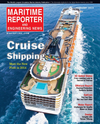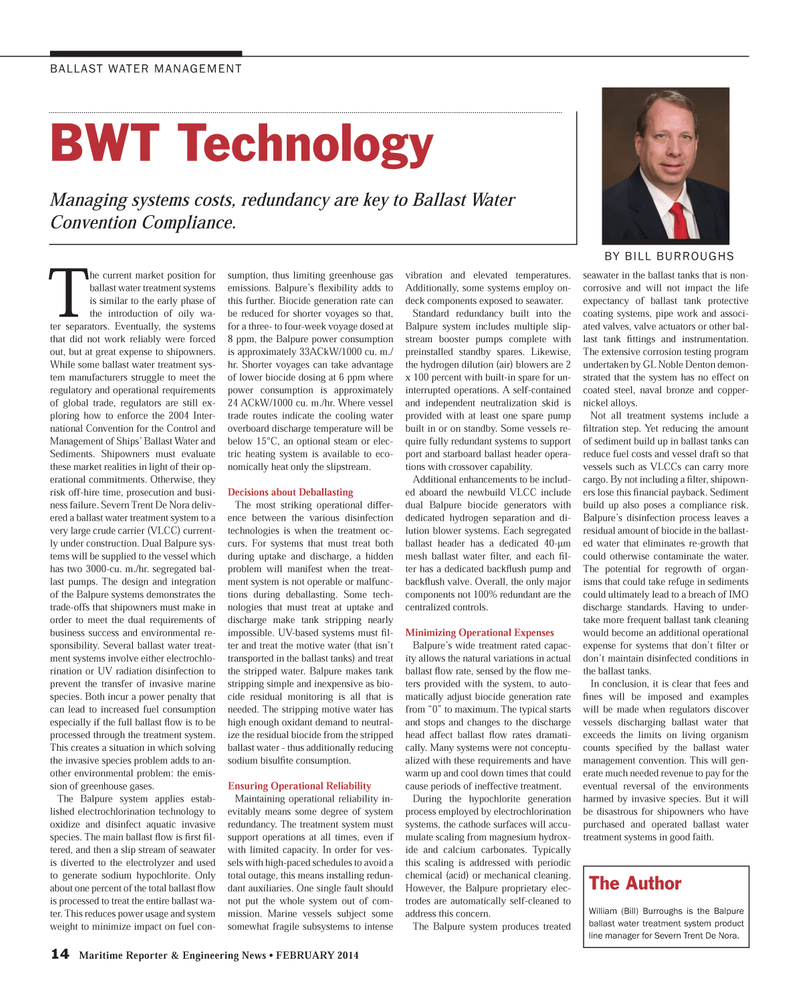
Page 14: of Maritime Reporter Magazine (February 2014)
Cruise Shipping Edition
Read this page in Pdf, Flash or Html5 edition of February 2014 Maritime Reporter Magazine
14 Maritime Reporter & Engineering News • FEBRUARY 2014
BALLAST WATER MANAGEMENT
T he current market position for ballast water treatment systems is similar to the early phase of the introduction of oily wa- ter separators. Eventually, the systems that did not work reliably were forced out, but at great expense to shipowners.
While some ballast water treatment sys- tem manufacturers struggle to meet the regulatory and operational requirements of global trade, regulators are still ex- ploring how to enforce the 2004 Inter- national Convention for the Control and
Management of Ships’ Ballast Water and
Sediments. Shipowners must evaluate these market realities in light of their op- erational commitments. Otherwise, they risk off-hire time, prosecution and busi- ness failure. Severn Trent De Nora deliv- ered a ballast water treatment system to a very large crude carrier (VLCC) current- ly under construction. Dual Balpure sys- tems will be supplied to the vessel which has two 3000-cu. m./hr. segregated bal- last pumps. The design and integration of the Balpure systems demonstrates the trade-offs that shipowners must make in order to meet the dual requirements of business success and environmental re- sponsibility. Several ballast water treat- ment systems involve either electrochlo- rination or UV radiation disinfection to prevent the transfer of invasive marine species. Both incur a power penalty that can lead to increased fuel consumption especially if the full ballast fl ow is to be processed through the treatment system.
This creates a situation in which solving the invasive species problem adds to an- other environmental problem: the emis- sion of greenhouse gases.
The Balpure system applies estab- lished electrochlorination technology to oxidize and disinfect aquatic invasive species. The main ballast fl ow is fi rst fi l- tered, and then a slip stream of seawater is diverted to the electrolyzer and used to generate sodium hypochlorite. Only about one percent of the total ballast fl ow is processed to treat the entire ballast wa- ter. This reduces power usage and system weight to minimize impact on fuel con- sumption, thus limiting greenhouse gas emissions. Balpure’s fl exibility adds to this further. Biocide generation rate can be reduced for shorter voyages so that, for a three- to four-week voyage dosed at 8 ppm, the Balpure power consumption is approximately 33ACkW/1000 cu. m./ hr. Shorter voyages can take advantage of lower biocide dosing at 6 ppm where power consumption is approximately 24 ACkW/1000 cu. m./hr. Where vessel trade routes indicate the cooling water overboard discharge temperature will be below 15°C, an optional steam or elec- tric heating system is available to eco- nomically heat only the slipstream.
Decisions about Deballasting
The most striking operational differ- ence between the various disinfection technologies is when the treatment oc- curs. For systems that must treat both during uptake and discharge, a hidden problem will manifest when the treat- ment system is not operable or malfunc- tions during deballasting. Some tech- nologies that must treat at uptake and discharge make tank stripping nearly impossible. UV-based systems must fi l- ter and treat the motive water (that isn’t transported in the ballast tanks) and treat the stripped water. Balpure makes tank stripping simple and inexpensive as bio- cide residual monitoring is all that is needed. The stripping motive water has high enough oxidant demand to neutral- ize the residual biocide from the stripped ballast water - thus additionally reducing sodium bisulfi te consumption.
Ensuring Operational Reliability
Maintaining operational reliability in- evitably means some degree of system redundancy. The treatment system must support operations at all times, even if with limited capacity. In order for ves- sels with high-paced schedules to avoid a total outage, this means installing redun- dant auxiliaries. One single fault should not put the whole system out of com- mission. Marine vessels subject some somewhat fragile subsystems to intense vibration and elevated temperatures.
Additionally, some systems employ on- deck components exposed to seawater.
Standard redundancy built into the
Balpure system includes multiple slip- stream booster pumps complete with preinstalled standby spares. Likewise, the hydrogen dilution (air) blowers are 2 x 100 percent with built-in spare for un- interrupted operations. A self-contained and independent neutralization skid is provided with at least one spare pump built in or on standby. Some vessels re- quire fully redundant systems to support port and starboard ballast header opera- tions with crossover capability.
Additional enhancements to be includ- ed aboard the newbuild VLCC include dual Balpure biocide generators with dedicated hydrogen separation and di- lution blower systems. Each segregated ballast header has a dedicated 40-µm mesh ballast water fi lter, and each fi l- ter has a dedicated backfl ush pump and backfl ush valve. Overall, the only major components not 100% redundant are the centralized controls.
Minimizing Operational Expenses
Balpure’s wide treatment rated capac- ity allows the natural variations in actual ballast fl ow rate, sensed by the fl ow me- ters provided with the system, to auto- matically adjust biocide generation rate from “0” to maximum. The typical starts and stops and changes to the discharge head affect ballast fl ow rates dramati- cally. Many systems were not conceptu- alized with these requirements and have warm up and cool down times that could cause periods of ineffective treatment.
During the hypochlorite generation process employed by electrochlorination systems, the cathode surfaces will accu- mulate scaling from magnesium hydrox- ide and calcium carbonates. Typically this scaling is addressed with periodic chemical (acid) or mechanical cleaning.
However, the Balpure proprietary elec- trodes are automatically self-cleaned to address this concern.
The Balpure system produces treated seawater in the ballast tanks that is non- corrosive and will not impact the life expectancy of ballast tank protective coating systems, pipe work and associ- ated valves, valve actuators or other bal- last tank fi ttings and instrumentation.
The extensive corrosion testing program undertaken by GL Noble Denton demon- strated that the system has no effect on coated steel, naval bronze and copper- nickel alloys.
Not all treatment systems include a fi ltration step. Yet reducing the amount of sediment build up in ballast tanks can reduce fuel costs and vessel draft so that vessels such as VLCCs can carry more cargo. By not including a fi lter, shipown- ers lose this fi nancial payback. Sediment build up also poses a compliance risk.
Balpure’s disinfection process leaves a residual amount of biocide in the ballast- ed water that eliminates re-growth that could otherwise contaminate the water.
The potential for regrowth of organ- isms that could take refuge in sediments could ultimately lead to a breach of IMO discharge standards. Having to under- take more frequent ballast tank cleaning would become an additional operational expense for systems that don’t fi lter or don’t maintain disinfected conditions in the ballast tanks.
In conclusion, it is clear that fees and fi nes will be imposed and examples will be made when regulators discover vessels discharging ballast water that exceeds the limits on living organism counts specifi ed by the ballast water management convention. This will gen- erate much needed revenue to pay for the eventual reversal of the environments harmed by invasive species. But it will be disastrous for shipowners who have purchased and operated ballast water treatment systems in good faith.
BWT Technology
Managing systems costs, redundancy are key to Ballast Water
Convention Compliance.
BY BILL BURROUGHS
The Author
William (Bill) Burroughs is the Balpure ballast water treatment system product line manager for Severn Trent De Nora.
MR #2 (10-17).indd 14 2/4/2014 9:32:19 AM

 13
13

 15
15
